Shuffling the Deck
Virtually every card game played, from Solitaire to Bridge, requires shuffling of the cards before each deal. Shuffling is the process of mixing the deck of cards before play such that their eventual ordering is thoroughly modified from their pre-shuffle arrangement. The basic goal of shuffling is to randomize the entire deck of cards in such a way that the specific whereabouts in the deck of any particular card is not known to any player.
There are a variety of standard shuffling methods and a brief description of the most common of these methods is given below. For more detailed information and step by step instructions on how to perform each of these shuffling techniques, see How To Shuffle.
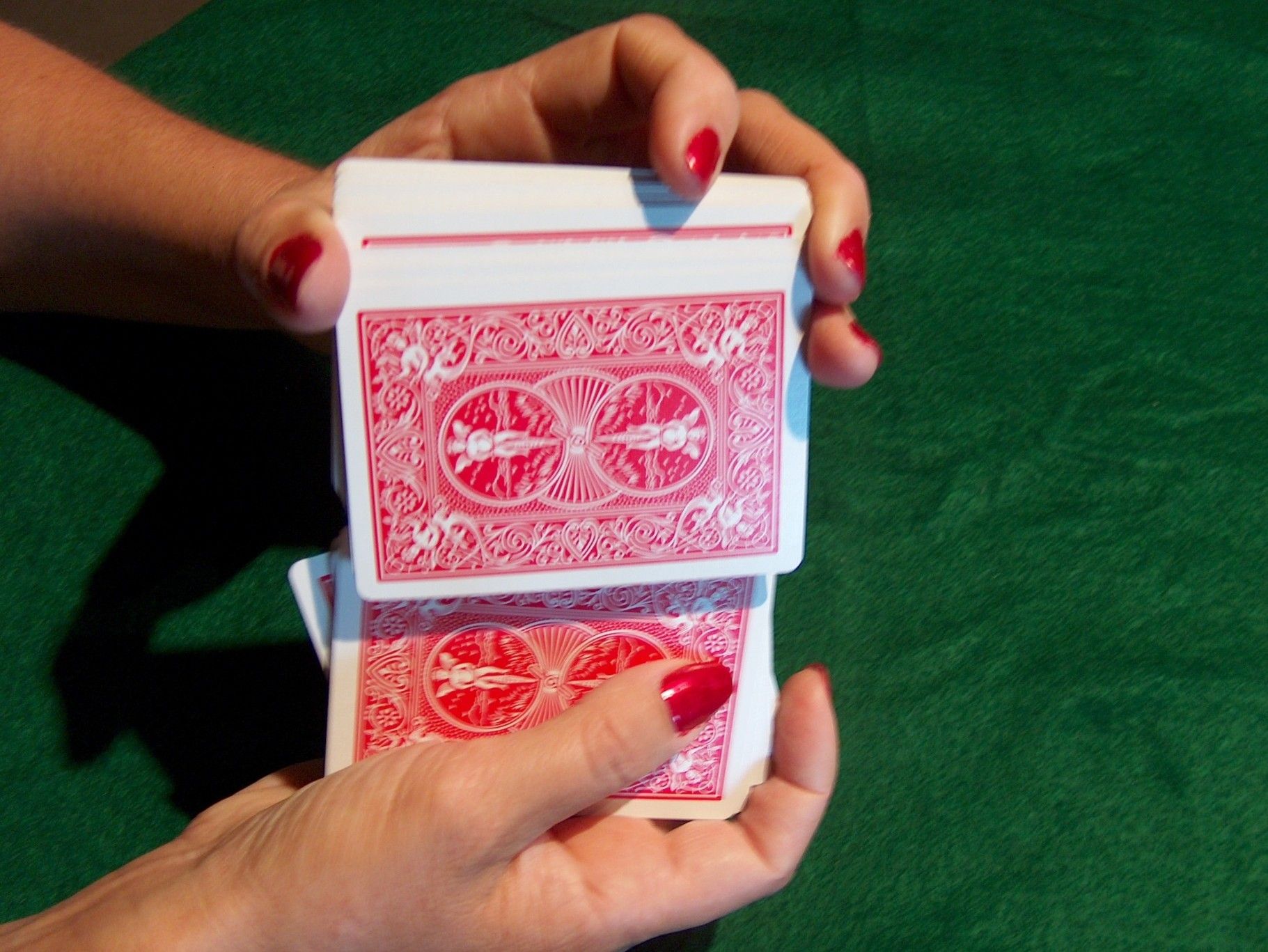 The Overhand Shuffle: This is one of the most common shuffles found at card tables around the world.
This is mainly because it is also one of the most easiest shuffles to perform. Although the overhand shuffle is quite simple, it does a fair job of randomizing and mixing the cards.
This shuffle essentially consists of holding the deck vertically and taking a large stack of cards from the back of the deck and sliding smaller portions from the top of this pile onto the front of the deck which is held by the other hand. This should be done repeatedly to ensure a high level of randomization. This shuffle is also often called stripping or the slide shuffle. For step by step instructions on how to perform the Overhand shuffle follow this link.
The Overhand Shuffle: This is one of the most common shuffles found at card tables around the world.
This is mainly because it is also one of the most easiest shuffles to perform. Although the overhand shuffle is quite simple, it does a fair job of randomizing and mixing the cards.
This shuffle essentially consists of holding the deck vertically and taking a large stack of cards from the back of the deck and sliding smaller portions from the top of this pile onto the front of the deck which is held by the other hand. This should be done repeatedly to ensure a high level of randomization. This shuffle is also often called stripping or the slide shuffle. For step by step instructions on how to perform the Overhand shuffle follow this link.
 The Weave Shuffle: The Weave shuffle is another one of the less complicated shuffles to accomplish. The weave shuffle consists of essentially sliding two halves of the deck together such that they weave together with cards from both piles integrating into a single pile. The cards are intended to merge together in such a way that both halves are intermingled breaking up any previous ordering of the deck. The ideal such shuffle would be one in which the final stack would consist of one alternating card from each pile in a repeated pattern. When this shuffle is performed with the deck first split into two exactly equal packets before weaving the packets and the two packets are pushed together such that they do exactly alternating intermingle, this is called a Faro shuffle. Click on this link for instructions on how to perform the Weave shuffle.
The Weave Shuffle: The Weave shuffle is another one of the less complicated shuffles to accomplish. The weave shuffle consists of essentially sliding two halves of the deck together such that they weave together with cards from both piles integrating into a single pile. The cards are intended to merge together in such a way that both halves are intermingled breaking up any previous ordering of the deck. The ideal such shuffle would be one in which the final stack would consist of one alternating card from each pile in a repeated pattern. When this shuffle is performed with the deck first split into two exactly equal packets before weaving the packets and the two packets are pushed together such that they do exactly alternating intermingle, this is called a Faro shuffle. Click on this link for instructions on how to perform the Weave shuffle.
The Riffle Shuffle: This is another very common shuffle used in card games the world over. This is one of the more formal and elegant shuffles when performed correctly. This is also the shuffle often seen portrayed on film and other media when cards are played. This shuffle consists of breaking the dividing the deck into two approximately equal piles and riffling the two piles together. The idea is to have cards from both piles alternate into one pile. As in other shuffles, this shuffle should be performed multiple times in order to thoroughly randomize the resulting deck. Although many game rules recommend 3 to 4 such shuffles it has been shown that seven shuffles is best for complete randomization of the entire deck. Although usually performed on the table, this shuffle can also be performed completely in the hands, although this is slightly more difficult. The end result of the shuffle is, of course, the same. Many people who use this shuffle complete the shuffle by cascading the cards downwards, after the completion of the actual shuffle, back into the full deck shape. This cascade does not actually contribute any additional randomization to the shuffle but serves to give the shuffle an elegant finish and quickly squares up the deck. This shuffle is sometimes also called the dovetail shuffle. This shuffle can sometimes put more wear on a pack of cards than some of the other shuffles. The following link describes detailed instructions on how to perform the Riffle shuffle. Sometimes this shuffle will be performed in such a manner that only the corners of the actual cards riffle together. Although the procedures and end result is the same, this is sometimes done as it causes slightly less wear on the cards during the shuffling process.
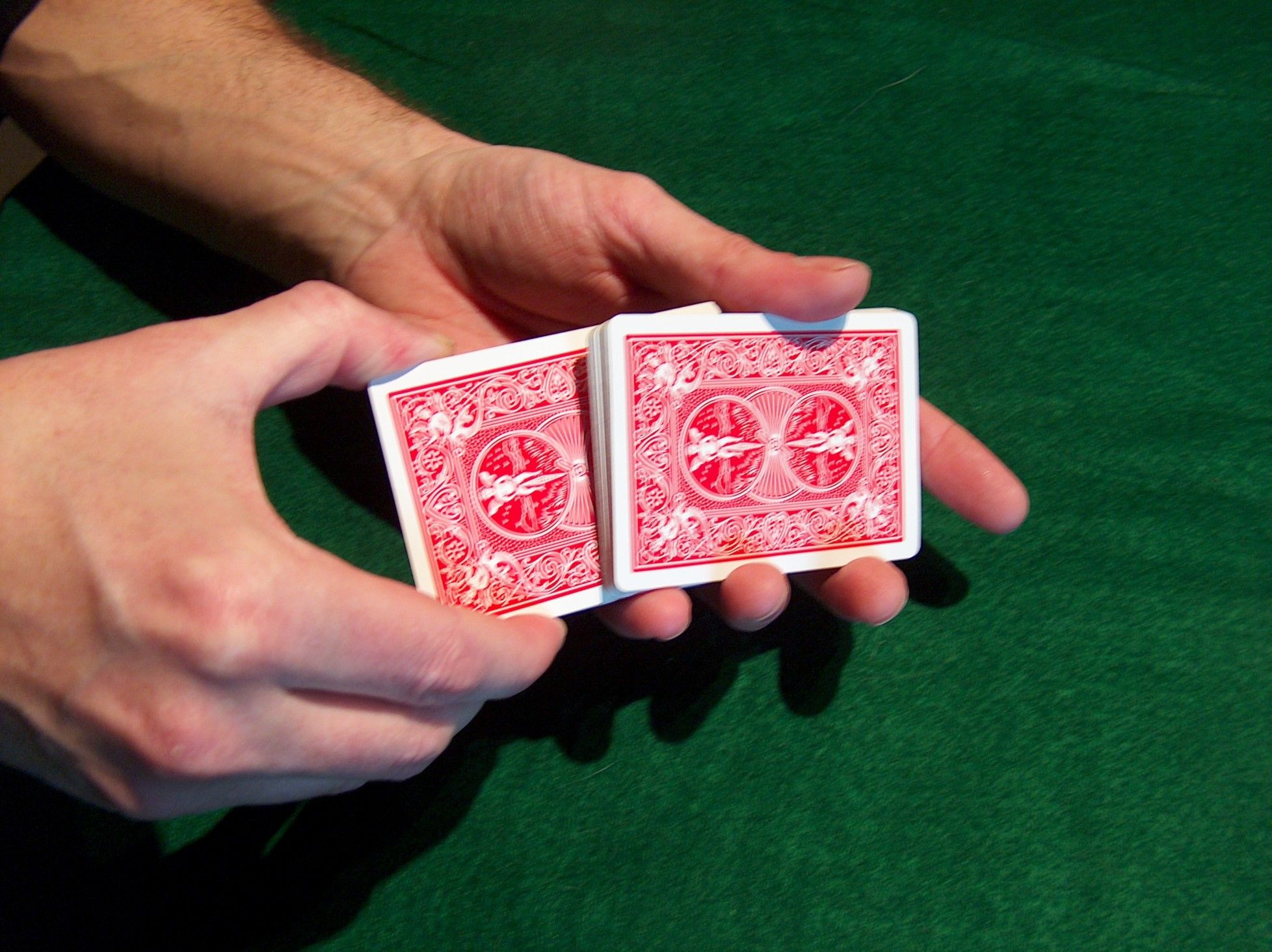 The Hindu Shuffle: The Hindu Shuffle is another common shuffle and is somewhat similar to the overhand shuffle. The Hindu shuffle consists of taking small piles of cards from the deck held in one hand and allowing these piles to drop into a growing stack in the other hand which is held slightly lower. The deck essentially starts in one hand and ends up, in an altered ordering in the other hand at the end of each such shuffle. This shuffle is also called the Kutti shuffle. Click the following link for detailed step by steps instructions on performing the Hindu shuffle.
The Hindu Shuffle: The Hindu Shuffle is another common shuffle and is somewhat similar to the overhand shuffle. The Hindu shuffle consists of taking small piles of cards from the deck held in one hand and allowing these piles to drop into a growing stack in the other hand which is held slightly lower. The deck essentially starts in one hand and ends up, in an altered ordering in the other hand at the end of each such shuffle. This shuffle is also called the Kutti shuffle. Click the following link for detailed step by steps instructions on performing the Hindu shuffle.
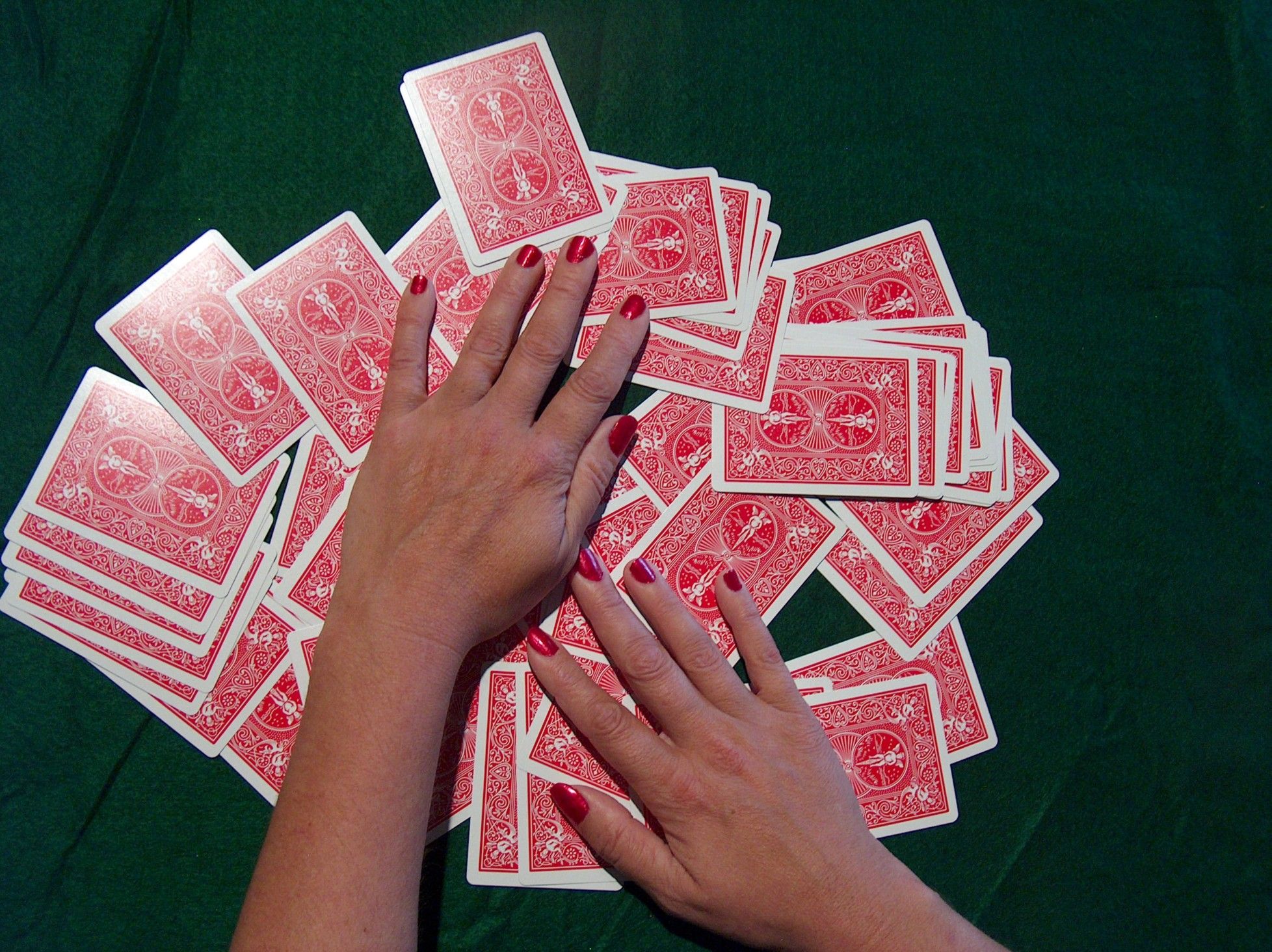 The Wash Shuffle: This very informal and basic shuffle is also known by a number of other names such as the Irish shuffle, Beginner shuffle and The Scramble. It is probably one of the easiest shuffles to perform and is often used by beginners. This shuffle essentially consists of spreading all the cards face down on the table and sliding them randomly around the table by the players. After a thorough mixing in this manner, the cards are then gathered up into a face down stack. This shuffle requires a fairly large amount of room to perform and takes longer than most other shuffle. Although it is a very basic and beginner shuffle, it generally does do quite a good job of randomizing the cards.
This shuffle is also sometimes the first shuffle done when removing the plastic seal and opening a new deck of cards and is called washing the deck. Click this link for instructions on how to perform the Wash shuffle.
The Wash Shuffle: This very informal and basic shuffle is also known by a number of other names such as the Irish shuffle, Beginner shuffle and The Scramble. It is probably one of the easiest shuffles to perform and is often used by beginners. This shuffle essentially consists of spreading all the cards face down on the table and sliding them randomly around the table by the players. After a thorough mixing in this manner, the cards are then gathered up into a face down stack. This shuffle requires a fairly large amount of room to perform and takes longer than most other shuffle. Although it is a very basic and beginner shuffle, it generally does do quite a good job of randomizing the cards.
This shuffle is also sometimes the first shuffle done when removing the plastic seal and opening a new deck of cards and is called washing the deck. Click this link for instructions on how to perform the Wash shuffle.
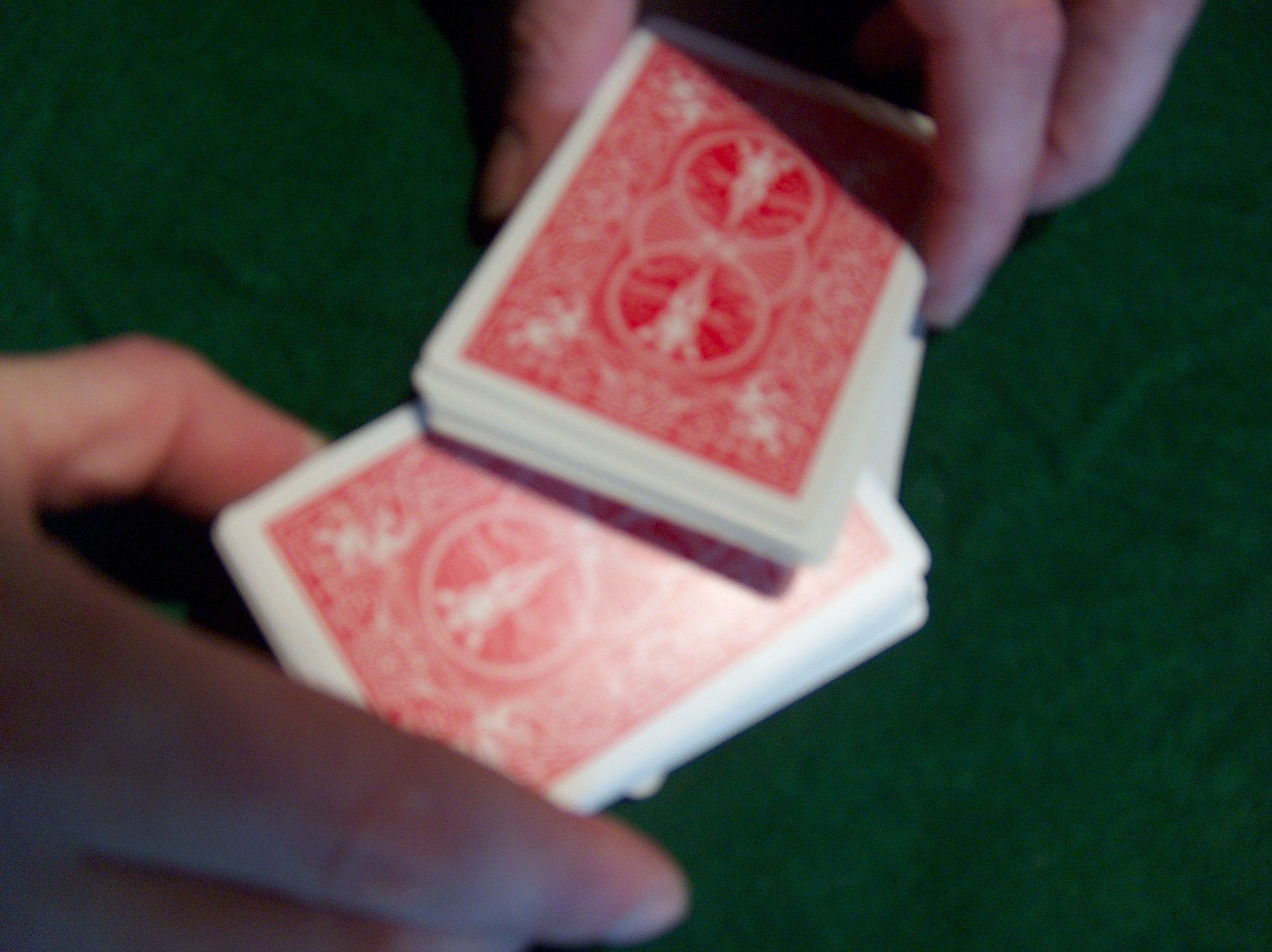 The Running Cut Shuffle: This shuffle also called the strip shuffle, is an easy one to perform and is often used in conjunction with one of the other shuffle methods, such as the Riffle shuffle. This shuffle essentially consists of pulling small stacks from the top of a full deck and adding them to a new, growing stack. This is continued until the last small stack is simply placed on top of the new stack, completing the shuffle. This shuffle is usually performed with the deck in a length-wise orientation. This shuffle should generally be repeated a number of times to ensure more randomization of the deck. Click this link for step-by-step instructions for performing the Running Cut shuffle.
The Running Cut Shuffle: This shuffle also called the strip shuffle, is an easy one to perform and is often used in conjunction with one of the other shuffle methods, such as the Riffle shuffle. This shuffle essentially consists of pulling small stacks from the top of a full deck and adding them to a new, growing stack. This is continued until the last small stack is simply placed on top of the new stack, completing the shuffle. This shuffle is usually performed with the deck in a length-wise orientation. This shuffle should generally be repeated a number of times to ensure more randomization of the deck. Click this link for step-by-step instructions for performing the Running Cut shuffle.
Other Shuffling Methods: Card players will sometimes encounter other shuffling methods as well, many of which are hybrid combinations of the shuffling techniques above. There are also many regional shuffling techniques that might be found used in a particular region or area. In most cases these alternate methods also do a fair job of ensuring randomization of the cards when performed an adequate number of times.
Derived Shuffling Methods: Other methods of shuffling would also include several "artificial" methods of shuffling. These types of shuffles are very deliberate shuffles in which a very specific pattern is followed in the shuffle, often for each individual card. These type of shuffles include the Mongean Shuffle and the Pile shuffle. As these shuffles usually can take a long time and require specific handling of each card, these types of shuffles are typically not actually used at many card games, but they represent good models or examples for randomization. Click here for more information about these methods and detailed instructions on how to perform some of these derived shuffles.
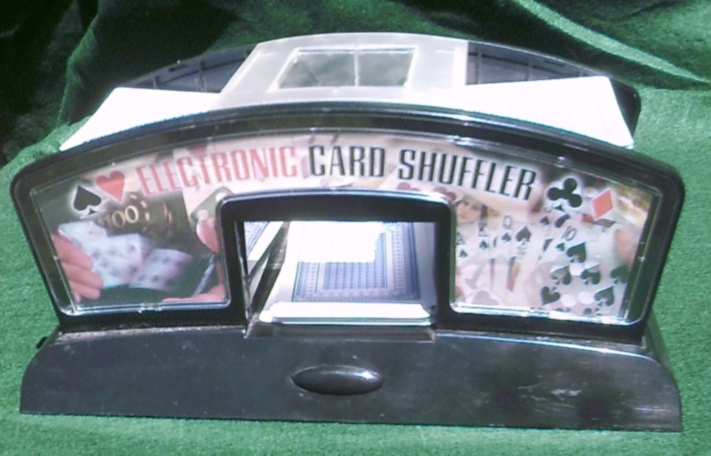 Automatic Shufflers: There are a number of automatic, electronic shuffling machines on the market that automate the job of shuffling. These often consist of a device that approximately simulates, in mechanical form, the performance of the riffle shuffle. In these type of shuffling machines the deck is usually cut in two halves and placed on trays in the machine. When activated the machine then combines the two stacks into one pile which contains a mixing of cards from both piles. There are also available other very sophisticated computer controlled shuffling machines which can highly randomize the cards in just one pass through. As in most manual shuffles, for best randomization, with most of these machines, the cards should be passed through the machine several times before beginning the deal.
Automatic Shufflers: There are a number of automatic, electronic shuffling machines on the market that automate the job of shuffling. These often consist of a device that approximately simulates, in mechanical form, the performance of the riffle shuffle. In these type of shuffling machines the deck is usually cut in two halves and placed on trays in the machine. When activated the machine then combines the two stacks into one pile which contains a mixing of cards from both piles. There are also available other very sophisticated computer controlled shuffling machines which can highly randomize the cards in just one pass through. As in most manual shuffles, for best randomization, with most of these machines, the cards should be passed through the machine several times before beginning the deal.
General Guidelines: In any shuffle the cards should be kept face down and handled in such a way that no card is exposed or can be viewed by any person at the table (including the individual performing the shuffle).
Some of the shuffling techniques randomize more than others in each pass, so it's always best to perform each shuffle multiple times.
The specific number of shuffles that is needed would also be determined by not only the shuffling technique used but also the specific way in which the individual performs that shuffle.
For most average card players, generally 3 to 4 shuffles is sufficient for most shuffling techniques in the casual game of cards. However for almost complete and total randomization, it is widely accepted that 7 shuffles is an appropriate number, particularly with the more popular shuffling methods such as the riffle shuffle.
The cards should be shuffled before any cutting for partnerships or first dealer is accomplished as well as before beginning the actual play of the game. The dealer is usually responsible for shuffling the deck before the hand is dealt, although, on occasion other players may be enlisted to perform the shuffle as well. In games that require an extra large stack of cards, the deck may actually be shuffled in sections (by either the dealer or with the help of other players as well) with the individual section then randomly stacked back together to reform the full deck.
At the completion of each shuffle the deck should be squared up and aligned in a neat pile, face down, either in preparation for additional shuffling, cutting or dealing the hand.
After the last shuffle before the deal of the hand, the player to the dealers immediate right (or immediate left in some locales) would be offered the deck for cutting. The direction of this hand off of the deck (either to the dealers right or left) is the opposite of the normal direction of deal and play being used at the table.
Copyright © 2015
CatsAtCards.com. All rights reserved.


 The Overhand Shuffle: This is one of the most common shuffles found at card tables around the world.
This is mainly because it is also one of the most easiest shuffles to perform. Although the overhand shuffle is quite simple, it does a fair job of randomizing and mixing the cards.
This shuffle essentially consists of holding the deck vertically and taking a large stack of cards from the back of the deck and sliding smaller portions from the top of this pile onto the front of the deck which is held by the other hand. This should be done repeatedly to ensure a high level of randomization. This shuffle is also often called stripping or the slide shuffle. For step by step instructions on how to perform the Overhand shuffle follow this link.
The Overhand Shuffle: This is one of the most common shuffles found at card tables around the world.
This is mainly because it is also one of the most easiest shuffles to perform. Although the overhand shuffle is quite simple, it does a fair job of randomizing and mixing the cards.
This shuffle essentially consists of holding the deck vertically and taking a large stack of cards from the back of the deck and sliding smaller portions from the top of this pile onto the front of the deck which is held by the other hand. This should be done repeatedly to ensure a high level of randomization. This shuffle is also often called stripping or the slide shuffle. For step by step instructions on how to perform the Overhand shuffle follow this link.
 The Weave Shuffle: The Weave shuffle is another one of the less complicated shuffles to accomplish. The weave shuffle consists of essentially sliding two halves of the deck together such that they weave together with cards from both piles integrating into a single pile. The cards are intended to merge together in such a way that both halves are intermingled breaking up any previous ordering of the deck. The ideal such shuffle would be one in which the final stack would consist of one alternating card from each pile in a repeated pattern. When this shuffle is performed with the deck first split into two exactly equal packets before weaving the packets and the two packets are pushed together such that they do exactly alternating intermingle, this is called a Faro shuffle. Click on this link for instructions on how to perform the Weave shuffle.
The Weave Shuffle: The Weave shuffle is another one of the less complicated shuffles to accomplish. The weave shuffle consists of essentially sliding two halves of the deck together such that they weave together with cards from both piles integrating into a single pile. The cards are intended to merge together in such a way that both halves are intermingled breaking up any previous ordering of the deck. The ideal such shuffle would be one in which the final stack would consist of one alternating card from each pile in a repeated pattern. When this shuffle is performed with the deck first split into two exactly equal packets before weaving the packets and the two packets are pushed together such that they do exactly alternating intermingle, this is called a Faro shuffle. Click on this link for instructions on how to perform the Weave shuffle.


 The Hindu Shuffle: The Hindu Shuffle is another common shuffle and is somewhat similar to the overhand shuffle. The Hindu shuffle consists of taking small piles of cards from the deck held in one hand and allowing these piles to drop into a growing stack in the other hand which is held slightly lower. The deck essentially starts in one hand and ends up, in an altered ordering in the other hand at the end of each such shuffle. This shuffle is also called the Kutti shuffle. Click the following link for detailed step by steps instructions on performing the Hindu shuffle.
The Hindu Shuffle: The Hindu Shuffle is another common shuffle and is somewhat similar to the overhand shuffle. The Hindu shuffle consists of taking small piles of cards from the deck held in one hand and allowing these piles to drop into a growing stack in the other hand which is held slightly lower. The deck essentially starts in one hand and ends up, in an altered ordering in the other hand at the end of each such shuffle. This shuffle is also called the Kutti shuffle. Click the following link for detailed step by steps instructions on performing the Hindu shuffle.
 The Wash Shuffle: This very informal and basic shuffle is also known by a number of other names such as the Irish shuffle, Beginner shuffle and The Scramble. It is probably one of the easiest shuffles to perform and is often used by beginners. This shuffle essentially consists of spreading all the cards face down on the table and sliding them randomly around the table by the players. After a thorough mixing in this manner, the cards are then gathered up into a face down stack. This shuffle requires a fairly large amount of room to perform and takes longer than most other shuffle. Although it is a very basic and beginner shuffle, it generally does do quite a good job of randomizing the cards.
This shuffle is also sometimes the first shuffle done when removing the plastic seal and opening a new deck of cards and is called washing the deck. Click this link for instructions on how to perform the Wash shuffle.
The Wash Shuffle: This very informal and basic shuffle is also known by a number of other names such as the Irish shuffle, Beginner shuffle and The Scramble. It is probably one of the easiest shuffles to perform and is often used by beginners. This shuffle essentially consists of spreading all the cards face down on the table and sliding them randomly around the table by the players. After a thorough mixing in this manner, the cards are then gathered up into a face down stack. This shuffle requires a fairly large amount of room to perform and takes longer than most other shuffle. Although it is a very basic and beginner shuffle, it generally does do quite a good job of randomizing the cards.
This shuffle is also sometimes the first shuffle done when removing the plastic seal and opening a new deck of cards and is called washing the deck. Click this link for instructions on how to perform the Wash shuffle.
 The Running Cut Shuffle: This shuffle also called the strip shuffle, is an easy one to perform and is often used in conjunction with one of the other shuffle methods, such as the Riffle shuffle. This shuffle essentially consists of pulling small stacks from the top of a full deck and adding them to a new, growing stack. This is continued until the last small stack is simply placed on top of the new stack, completing the shuffle. This shuffle is usually performed with the deck in a length-wise orientation. This shuffle should generally be repeated a number of times to ensure more randomization of the deck. Click this link for step-by-step instructions for performing the Running Cut shuffle.
The Running Cut Shuffle: This shuffle also called the strip shuffle, is an easy one to perform and is often used in conjunction with one of the other shuffle methods, such as the Riffle shuffle. This shuffle essentially consists of pulling small stacks from the top of a full deck and adding them to a new, growing stack. This is continued until the last small stack is simply placed on top of the new stack, completing the shuffle. This shuffle is usually performed with the deck in a length-wise orientation. This shuffle should generally be repeated a number of times to ensure more randomization of the deck. Click this link for step-by-step instructions for performing the Running Cut shuffle.